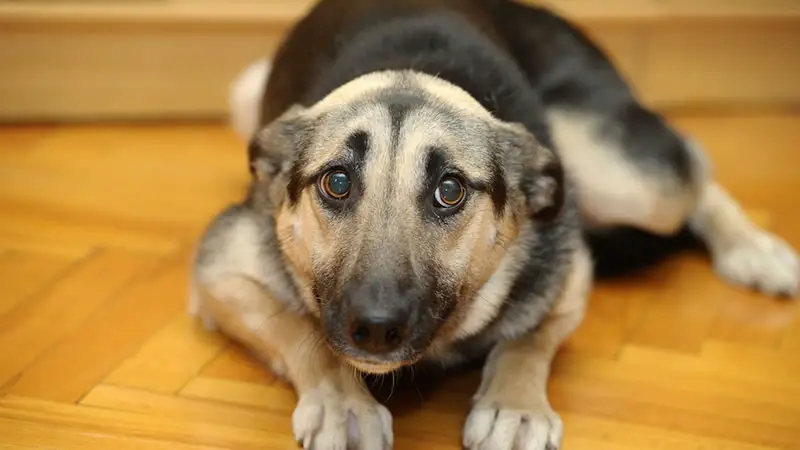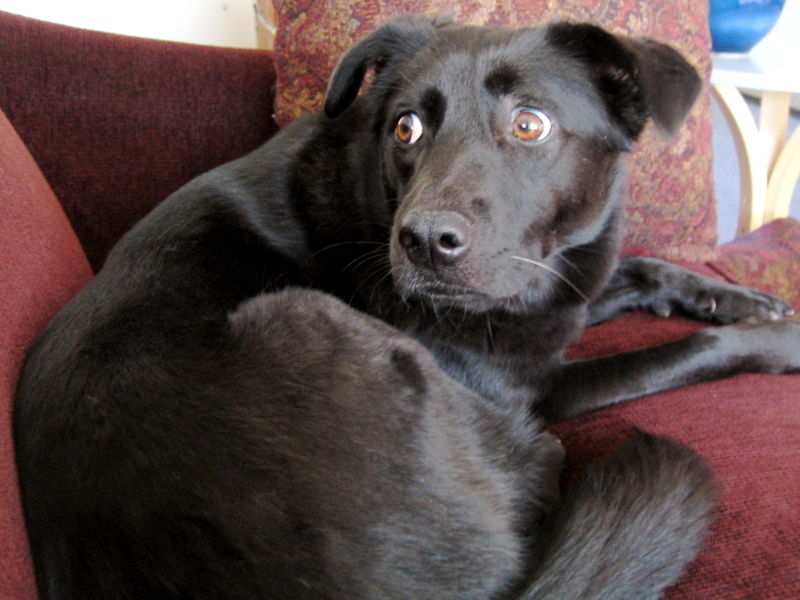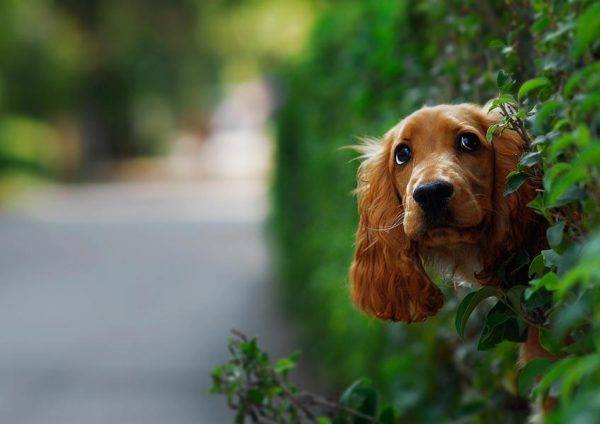Even a perfectly normal and healthy dog gets scared in certain situations, this is a completely natural reaction. In most cases, the dog, having made sure several times that the explosion of a firecracker or thunder does not cause him any harm, stops responding to them. The problem arises if the fear persists and causes the animal to panic. Usually, the solution is to train the dog not to be afraid of being shot. The fact is that if an animal is not afraid of shots, then it is not afraid of other sounds – be it thunder, a burst car tire, or fireworks. So, let’s take a closer look at what causes fears and what to do if the dog is afraid of shots, thunderstorms, fireworks, and loud sounds in general.
Causes of Dog Fears

The reasons why a dog is afraid of loud noises and noise in the street can be very different. Usually psychological trauma, horror experienced once is to blame. The too strong influence that the dog has undergone “breaks through the isolation” and there is an abnormal stable connection between certain nerve centers, which manifests itself in all cases when the dog is subsequently faced with similar stimuli.
It is not always possible to identify the specific cause of persistent pathological fears. Let’s imagine that a large dog attacked a puppy, ripped out a tuft of fur, and frightened a strong one. At the same time, a motorcycle roared past with a roar, which you, keen on saving the puppy, simply did not pay attention to. The puppy may subsequently be afraid of big dogs all his life, or maybe the sound of a motorcycle. There was a case when it turned out that a dog fearing shots is not afraid of the shots themselves. She was not afraid of loud noises for a very long time, but once she was scared by fireworks. As a result, the dog became afraid of shots only because he had a belief that shots and fireworks are related. Hearing a shot, she immediately hides under a sofa or bush. That is, the shot became a kind of warning for her that now fireworks will take off and an urgent need to hide.
A weak stimulus can also “breakthrough isolation” if it acts constantly and each time causes negative sensations in the dog (that is, the dog constantly receives confirmation that this or that phenomenon or object is dangerous). For example, if you punish your pet every time the doorbell rings, the animal may have a panic fear of the ringing sound. Pathological fears can develop due to a weak nervous system, in dogs raised in an impoverished or nervous environment.
Dos and Don’ts When Teaching Your Dog to Loud Noises

When getting started with fears in puppies and adult dogs, it is important to follow the rules:
Don’t try to calm your dog down with hugs or petting! When a dog is scared, the first reaction of a person is to press, to pick up. These are characteristic reactions of a primate, and they will affect a frightened baby monkey. But a puppy (with the exception of very small ones), and even more so an adult dog, cannot be reassured in this way. When the dog is severely frightened, any physical limitation of movement is perceived as blocking the path to escape, and thereby sharply increases the fear. Next to you, the pet may feel a little more confident, it may even begin to cuddle up to its feet, but this is just an attempt to protect itself. He does not wait for your embrace, for him, protection is expressed like this – either you block him from danger, or you pounce on the enemy.
Do not pet or treat your dog when you panic! Verbal praise, stroking, and giving treats will be perceived by the animal as approval of behavior and confirmation that one really needs to be afraid. The dog may take food from you, but in general, this will only make the situation worse.
Don’t punish the dog! Shouting, jerking the leash, or hitting the dog when it is frightened of fireworks, thunder or other harsh sound is completely unacceptable.
Do not panic! If your dog is afraid of something that is not in real danger, ignore the fear and remain completely calm. Do not let her off the leash if you know that you may face “danger” (if the dog is afraid of fireworks, in no case do not walk off the leash on May 9 and on New Year’s holidays). If the dog is on a leash, then not only ignore the fear but also do not give any commands. Your equanimity will show the dog that there is nothing to be afraid of. If the dog is off-leash and takes flight, try to stop it with a loud, calm command (not threatening). Do not try to chase the dog, it will only increase its fear. Calmly follow her, occasionally shouting the nickname in a friendly voice. It is clear that in such a situation the animal can get hit by a car, but chasing with screams will definitely not improve the situation, but, on the contrary, will increase the chance of an accident.
Don’t shock therapy! Some owners deliberately expose the dog to “scary” influences. The logic is that a dog cannot be afraid all the time, it must understand that loud sounds and noise are not harmful. This technique works in very, very rare cases. If a dog has a strong fear of shots, then by detonating firecrackers under his nose, you will not cure him of fear, but turn a simple fear into a panic. Continuing training, you have a high chance to cripple the psyche of the animal or kill it. After all, severe stress can kill a dog, just as it kills a person.
How to Wean a Puppy Under 6 Months From “Scary” Sounds and Objects
Small puppies can be afraid of a variety of sounds and objects: strumming carts, rustling bags, vacuum cleaner, hairdryer. Fear is usually caused by loud noises and impending large objects. It is clear that the combination of one with the other is most terrible. Each puppy has its own fears: for one there is nothing worse than an old woman with a cart, the other is frightened by the grinding of a suitcase being pulled out from under the sofa. As you grow older, some fears may disappear, others appear. Today the puppy looks with suspicion at a passer-by with a rustling bag and calmly walks past the crying child, after a few days he stops paying attention to the bags but begins to shy away from the children. So up to 6 months, it makes no sense to specially train the puppy to any things and sounds – the puppy will overcome most of its fears on its own. But you can help him. Among other things, this will strengthen the baby’s confidence in the owner.
The basic rule is that if the puppy is frightened of something, you cannot raise your voice to him or somehow express your dissatisfaction. Do not force the puppy to approach the “scary” object. Have him examine the object that frightened him from a safe distance. Do not try to calm your dog down with affection and treats. If you see that the baby, observing the “scary” object, calmed down on his own, then you can praise and treat. It is not recommended to deliberately get into or create situations that cause a strong fear in the puppy. With these methods, you will not make the dog bold but only reinforce the cowardly behavior.
By 6 months, the puppy will get rid of most of its childhood fears, and then it will be possible to take care of those that remain.
How to Wean an Adult Dog From Being Afraid of Gunshots and Loud Noises
Attention! Exercise is only suitable for persons over 18 years of age.
If you have an adult dog who has a constant fear of fireworks and other loud noises on the street or at home, then it can be quite difficult to cure it. The fact is that in a state of panic, the animal literally loses its head and, as a result, educational measures do not work. However, there is a fairly reliable method that allows you to permanently wean a dog to be afraid of loud sounds, it is called – gradual training. The essence of the method is to gradually increase the stimulus or gradually reduce the distance from it to the dog.
As already mentioned, accustoming to loud noises usually boils down to learning not to be afraid of gunshots. If the dog is not afraid of them, then, as a rule, he is not afraid of other loud sounds, such as New Year’s fireworks or thunder. For training you will need:
- starting pistol (signal, sound), which is used in sports competitions to carry out a blank shot at the start;
- an assistant who will shoot;
- goodies.
Now let’s look at step by step how to teach a dog not to be afraid of shots.
Stage 1: Teaching Your Dog Not to Be Afraid of Long Range Shots
It is better to start training in a place that is familiar and safe for the dog. First, give her a good sniff of the pistol and treat her with a treat, then hand the weapon over to the assistant. Next, you keep the dog on a leash, and the assistant moves 150 steps away and shoots up. If the pet is not scared, then immediately after the shot, praise him and treat him with a treat. If he is frightened, do the same when he is completely calm. If you are very frightened, tell the assistant to move further. The next shot can be carried out only when the dog has completely recovered from the current one.
When the dog is no longer afraid of shooting at a given distance, shorten it by 20-30 steps. When it stops responding at this distance, cut back further. But most importantly, take your time! It is better to decrease the distance too slowly than too quickly. And it’s better to start learning too far than too little. Over time, begin to move the training to places less familiar to the dog and more lively. At the end of each session, as well as at the beginning, let the dog sniff the gun and reward it with a treat.
The guidelines for this exercise are as follows: the dog must react calmly to a flare gunshot at a distance of up to 15 meters (20 steps). However, it will be better if you teach her not to be afraid of shooting at all. You can start further training and shorten the distance only if the dog fulfills the standard well.
Train Your Dog to Shoot Close Up
At this stage, you will also need an assistant, and this should be a person whom the dog knows well. Give the command “Sit”, let the dog sniff the gun, and treat him to a treat. Then, without unfastening the leash, move 2-3 steps away from it. At the same time, the assistant takes the weapon for himself, moves away from the dog at a distance of 10-15 steps, and shoots. If everything went well, proceed to the next exercise.
Order “Sit” and pass the leash to the assistant. Pet the dog, let it sniff the gun, treat it and re-command “Sit!” Move back to the standard distance of 20 steps and fire. Go back, reward the dog with a treat and sniff the gun again. Next, start training without an assistant – shoot yourself and make sure that the dog remains sitting quietly when firing. When this stage is also passed, start calling the dog after the shot with the command “To me”, praise the dog that comes up, and let’s sniff the pistol. Then gradually reduce the distance. Ideal when the dog keeps the command “Sit” when fired in close proximity to him.
At the beginning of the training and further, every time you move on to a new exercise, you should not shoot several times in a row. Wait about 15 minutes, make sure the dog is completely calm, and only then take the next shot. If, on the next shot, the animal is frightened in the same way as during the first one, or more, stop training and resume it only the next day, increasing the distance. However, at the end of the stage, it is helpful to train the dog to fire the round.
Sometimes it happens that the dog gets stuck at a certain stage of training. For example, a pet does not react to shooting from a distance of 60 steps, but any attempt to close the distance starts to panic. Or the dog is calm about the shot when the owner is nearby, but hesitates, it is worth moving away from it a couple of steps. Or “holds” single shots well, but is afraid of a series. This behavior suggests that at some point you were in a hurry and closed the distance too quickly. In this case, take a break for a week and start again from the first stage. Be careful not to jump to the next one prematurely.
Rules of Successful Training

Watch out for safety. Do not point a weapon at people and animals, you can “plant” their hearing or gouge out their eyes.
Take your time. The longer you train your dog, the more reliable and durable the result will be.
Make sure your dog does not run into an irritant outside of your training, otherwise everything you have gone through will go to waste. If the dog is afraid of fireworks, then you cannot guarantee his absence in the city. Therefore, the best option is to go to the country house.
Be patient. Classes can take quite a long time – about a month. And then it is recommended to train the pet for another month in order to achieve a sustainable result.
Complicate conditions. When the dog has fully mastered the exercises described in the lesson, it is necessary to accustom him to unexpected shots that are no longer fired during special training. Unexpected shots must first be fired at a great distance, gradually decreasing it.
Don’t give up. Even the most difficult cases can be dealt with these exercises. It’s just that the more severe the case, the greater the initial distance to the assistant should be, and the slower it should be reduced.

